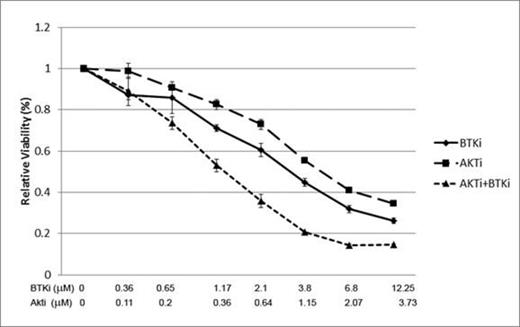Abstract
Background: Recent clinical trials have highlighted the therapeutic benefit of BTK inhibitors in lymphoma with varying degrees of activity dependent in part on morphology and genetic origin. There appears to be a proclivity of activity in activated B-cell-like (ABC) DLBCL, while the efficacy appears more limited in germinal center (GC) DLBCL. In addition, the activity of BTK inhibitors is not clear in TCL or HL. We sought to determine the in vitro effects of the investigational BTK inhibitor CC-292 as a single agent and in combination with several targeted small molecule inhibitors in DLBCL, TCL, and HL.
Methods: DLBCL cell lines (GC: SUDHL6, SUDHL10, Farage, and OCI-LY19; and ABC: OCI-LY3) were treated with increasing concentrations of CC-292 (0.1-20μM) alone and in combination with AKT inhibitor (AZD5363) and dual PI3K/mTOR inhibitor (BEZ235) for 24-72 hours. We analyzed cell viability with MTT assay and expression of NFκB, AKT, mTOR, MEK, and PARP by Western blot analysis. Calcusyn (Biosoft, Ferguson, MO) software program was used to analyze synergistic effects with drug combinations, based on isobologram and the method of Chou and Talay, a combination index (CI) value <1 indicates synergism. We also examined the efficacy (cytotoxicity by MTT) of CC-292 (0.1-10μM) in L428 HL and in Jurkat and HH TCL cell lines.
Results: Treatment with CC-292 resulted in a dose dependent decrease in cell viability in all DLBCL lines. The 50% inhibitory concentration (IC50) for Farage, OCI-LY19, SUDHL6, and SUDHL10 were 2.2μM, 6.3μM, 7.2μM, and 3.3μM respectively. Furthermore, treatment with 2.5 to 10μM of CC-292 effectively reduced phosphorylation of mTOR, AKT, and MEK, while it increased phosphorylation of NFκB (p65) and cleaved PARP in Farage, OCI-LY19, and SUDHL10. Treatment with CC-292 in combination with BEZ235 (PI3K/mTOR inhibitor) showed synergistic cell death in Farage cells (CI value at IC50, 75, and 90: 0.842, 0.731, and 0.661, respectively). Further, CC-292 treatment in combination with AZD5363 (AKT inhibitor) also resulted in synergistic cell death in Farage cells (CI value at IC50, 75, 90: 0.772, 0.771, 0.698) (Figure 1 ). In addition, CC-292 in combination with AZD5363 (AKT inhibitor) significantly down regulated phosphorylation of AKT and mTOR downstream targets, p70 S6K, and eIF4E by Western blotting compared with either drug as a single agent. Finally, in HL and TCL cells, CC-292 was highly effective in reducing cell viability with the following IC50 values in the presence of CC-292: 2.8μM and 2.2 μM for HH and Jurkat (TCL), respectively, and 7.1μM for L428 (HL) cells (Figure 2).
Conclusion: In summary, we demonstrated in this preclinical investigation the efficacy of the BTK inhibitor, CC-292, as a single agent as well as in synergistic combinations with an AKT small molecule inhibitor and a dual PI3K/mTOR inhibitor at clinically relevant doses in ABC-DLBCL and multiple GC-DLBCL cell lines. Furthermore, these synergistic combinations decreased mTOR and AKT dependent phosphorylation to a significant extent. Additionally, we demonstrated the cytotoxic effect of CC-292 in HL and TCL cell lines. Collectively, these results suggests that CC-292 is active as a single agent in TCL and HL and novel/novel combinations with PI3K/mTOR or AKT inhibitors may have potential therapeutic value in the treatment of DLBCL.
Farage lymphoma cells treated with CC-292, AKT inhibitor (AZD5363), or both and cell viability measured with MTT assay (72 hours).
Farage lymphoma cells treated with CC-292, AKT inhibitor (AZD5363), or both and cell viability measured with MTT assay (72 hours).
T-Cell Lymphoma (HH and Jurkat) and Hodgkin Lymphoma (L428) cell lines treated with CC-292 and cell viability measured by MTT assay (72 hours).
T-Cell Lymphoma (HH and Jurkat) and Hodgkin Lymphoma (L428) cell lines treated with CC-292 and cell viability measured by MTT assay (72 hours).
No relevant conflicts of interest to declare.
Author notes
Asterisk with author names denotes non-ASH members.



